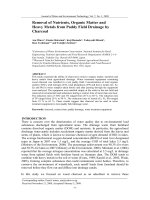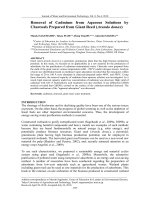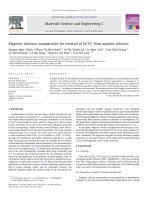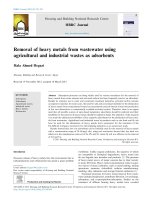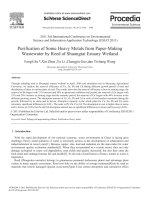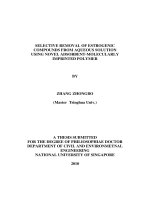semester report removal of heavy metals from aqueous environment by low cost adsorption materials rice husk and its ash
Bạn đang xem bản rút gọn của tài liệu. Xem và tải ngay bản đầy đủ của tài liệu tại đây (3.18 MB, 16 trang )
<span class="text_page_counter">Trang 1</span><div class="page_container" data-page="1">
VIETNAM GENERAL CONFEDERATION OF LABOUR
<b>TON DUC THANG UNIVERSITY </b>
<b>FACULTY OF ENVIRONMENT & LABOUR SAFETY</b>
<i><b>Class : 20090201</b></i>
THÀNH PHỐ HỒ CHÍ MINH, NĂM 2023
</div><span class="text_page_counter">Trang 2</span><div class="page_container" data-page="2">4. Characterizations of rice husk and rice husk ash...6
<b>II. USING RICE HUSK TO REMOVE HEAVY METAL...6</b>
1. Methods... 7
1.1. Treatment of rice husk... 7
2. Results and discussion...7
2.1. Effect of concentration...7
2.2. Effect of contact time...8
2.3. Adsorption dynamics...8
2.4. Isotherm studies...8
<b>III. USING RICE HUSK ASH TO REMOVE HEAVY METAL...10</b>
1. Materials and methods...10
</div><span class="text_page_counter">Trang 3</span><div class="page_container" data-page="3">Rice husk, which is a relatively abundant and inexpensive material, iscurrently being investigated as an adsorbent for the removal of heavy metalpollutants from water and wastewaters. Heavy metals can be removed veryeffectively with rice husk as an adsorbent. This article presents a brief review on therole of rice husk and rice husk ash in the removal of heavy metal from wastewater.Studies on the adsorption of heavy metal by rice husk materials are reviewed and theadsorption mechanism, influencing factors, favorable conditions, etc., discussed inthis report. It is evident from the review that rice husk and its ash can be potentiallyutilized for the removal of heavy metal from wastewaters.
<b>I. INTRODUCTION1. Heavy Metal</b>
Heavy metals are a group of metals and metalloids that have relatively highdensity and are toxic even at ppb levels. Examples include Pb, As, Hg, Cd, Zn, Ag,Cu, Fe, Cr, Ni, Pd, and Pt. These metals are released into the environment by bothnatural and anthropogenic sources such as industrial discharge, automobiles exhaust,and mining. Unlike organic pollutants, heavy metals are nonbiodegradable and havetendency to accumulate in living beings. In fact, most of them are known to bepotential carcinogens. Various adverse health hazards are known due to long termand continuous exposure to heavy metals. Since they are nondegradable and tend tobioaccumulate, suitable methods need to be established for their efficient removalfrom the environment. Guideline values for some of the heavy metals are listed intable(WHO, 2011) (Yadav et al., 2019)
<i>Table 1 Guideline values of heavy metals</i>
3
</div><span class="text_page_counter">Trang 4</span><div class="page_container" data-page="4"><b>2. Effects of heavy metals </b>
<b>2.1. Effects of heavy metal on environment</b>
Heavy metals have a high tendency to form complexes, are highly reactiveand have increased biochemical activity which makes them very persistent in theenvironment. They are transported through aqueous medium and can concentrate insoil and water resources. This makes them extremely dangerous to all kinds of lifeforms and the environment. Hence, it is necessary to remove these toxic metals fromwastewater before discharge to prevent further detrimental consequences.
<b>2.2. Effects of heavy metal on Human</b>
In addition to degrading the quality of natural waters, heavy metals can alsocause several serious health problems in humans, affecting the nervous system,kidney, liver, and respiratory functions(Shen et al., 2019). Most MTEs are stronglycarcinogenic(Shen et al., 2019).Also, MTEs can produce delays in the humangrowth and development, and disruption of bioregulatory systems responsible forfunctional or psychosomatic disorders, like chronic fatigue syndrome, andneurodegenerative pathologies, such as the Parkinson’s and Alzheimer’s diseases(Poey and Philibert 2000). Intoxication by some heavy metals, such as mercury andlead, can also lead to autoimmunity phenomena, in which the immune system of thepatient attacks his own cells. This can lead to joint diseases, such as rheumatoidarthritis, and kidney, circulatory, or nervous problems (Tian & Yang, 2007). (Sall etal., 2020)
<b>3. Absortion</b>
<b>3.1. Overview of adsorption process</b>
Adsorption is a surface phenomenon in which a solution containing theadsorbate gets adsorbed on the surface of an adsorbent. Adsorption phenomenon canbe of two types; one is physiosorption, in which the adsorbate binds to adsorbentdue to van der Waals forces, and other is chemisorption, which occurs due tochemical reactions between adsorbate and adsorbent. Physiosorption is reversible,weak and is usually endothermic, while chemisorption is irreversible, selective andexothermic (Tripathi & Ranjan, 2015)
<b>3.2. Adsorption isotherm and models</b>
Adsorption isotherms are representations that estimate the amount the solutethat is adsorbed on the surface of the adsorbent per unit weight as a function ofequilibrium concentration at a constant temperature. The most commonly used areLangmuir and Freundlich isotherms that describe the adsorption process (Langmuir,1916). Some other models are also used such as Redlich and Peterson (Redlich &Peterson, 1959), Radke and Prausnitz (Radke & Prausnitz, 1972), Sips (Sips, 1948),Toth (Toth, 1971)and Koble and Corrigan.(Koble & Corrigan, 1952)
4
</div><span class="text_page_counter">Trang 5</span><div class="page_container" data-page="5"><b>3.3. Types of adsorbents</b>
Adsorbents are typically classified on the basis of their origin i.e. natural andsynthetic. Natural adsorbents include clays, minerals, charcoal, ores and zeolites.While the synthetic adsorbents are prepared from industrial wastes, agriculturalwastes, waste sludge etc.
<b>3.4. Removal of heavy metals from wastewater by adsorption</b>
Adsorption is presumed to be an efficient and cost-effective method ascompared to other wastewater treatment technologies for heavy metal removal. Themain advantage this method provides is the production of a high-quality effluent.The process of adsorption has an edge over other processes since it is an economicmethod for heavy metal remediation. In most cases, the adsorbent can beregenerated back and can be used further (Ojedokun & Bello, 2016). Adsorption iseasy to use and does not generate any toxic pollutants, hence it is an environmentfriendly technique (Demirbas, 2008). The prominent criteria of selection ofadsorbents include their cost effectiveness, high surface area and porosity,distribution of functional groups and their polarity (Vunain et al.,2016), (Ewecharoen et al., 2009). Conventional and commercial adsorbentscomprise of activated carbon, zeolites, graphenes and fullerenes and carbonnanotubes. Carbons and their derivatives are the most prominently used adsorbentsdue their great adsorption efficiency. Their exceptional ability comes from theirstructural characteristics giving them a large surface area with easy chemicalmodifications which makes them universally acceptable to a wide spectrum ofpollutants (Crini et al., 2019). The activated carbons suffer from a few flaws whichmakes their use quite limited. They are expensive to manufacture; the spentactivated carbon is difficult to dispose and their regeneration is cumbersome and noteconomical. Thus, there was extensive research in the area of low-cost adsorbents.The non-conventional adsorbents are cheap, abundantly available and have greatcomplexing capacity due to their varied structure which binds the pollutant ions.They range from agricultural waste to industrial waste sludge and spent slurry(Crini, 2010),(Crini et al., 2018)
<b>4. Characterizations of rice husk and rice husk ash4.1 Characterizations of RH</b>
RH is the hard shell covering paddy rice seed, which provides nutrients andmetabolite accumulations during grain development, and protects seeds fromphysical damage and attacks by pathogens, insects, and pests. RH comprises twomajor, modified, leaf-like structures called the lemma and palea, which completelyencase the caryopsis. The structured layers of RH are divided into four categories,namely (1) the rough outer epidermis with surface hairs, where the silica is highlyconcentrated; (2) sclerenchyma; (3) spongy parenchyma cells; and (4) inner
5
</div><span class="text_page_counter">Trang 6</span><div class="page_container" data-page="6">epidermis, whose surface is relatively smooth and free of hair (Champagne et al.,2004)
<b>4.2 Characterizations of RHA</b>
RHA is a general term describing all types of ash produced by combustion ofRH. When RH is incinerated, it produces 17%–20% of RHA, which is a lightweight,bulky, and highly porous material with a density of around 180–200 kg/m3 . Thereare two types of RHA, that is, white rice husk ash (WRHA) and black rice husk ash(BRHA), depending on whether the combustion is complete or incomplete(Ugheoke & Mamat, 2012). The controlled combustion of RH in the atmosphere canlead to production of WRHA containing almost pure silica (>95%) in a hydratedamorphous form with high porosity and reactivity (Vlaev et al., 2003). Thecontrolled pyrolysis of RH in nitrogen or inert atmosphere results in production ofBRHA containing different amounts of carbon and silica (Ghaly & Mansaray, 1999).
<b>II. USING RICE HUSK TO REMOVE HEAVY METAL</b>
Adsorption behaviour of Ni(II), Zn(II), Cd(II) and Cr(VI) on untreated andphosphate-treated rice husk (PRH) showed that adsorption of Ni(II) and Cd(II) wasgreater when PRH was used as an adsorbent. Sorption of Cd(II) was dependent oncontact time, concentration, temperature, adsorbent doses and pH of the solution.The Langmuir constants and thermodynamic parameters have been calculated atdifferent temperatures. It was found that recovery of Cd(II) from syntheticwastewater by column operation was better than a batch process.(Ajmal et al., 2003)
<b>1. Methods</b>
<b>1.1. Treatment of rice husk</b>
Rice husk was obtained from a local mill, sieved (50– 60 mesh) size, washedseveral times with distilled water, dried at 60 C for 2 h and preserved at roomtemperature. Five gram dried-husk was treated with 100 ml of 1.0 M K2HPO4 for24 h. The mixture was filtered and washed several times with distilled water toremove the excess phosphate from the treated husk. The filtrate was tested for PO3 4ions by the standard method. The resultant adsorbent was finally dried at 70 C for 2h and preserved at room temperature in a sealed bottle. All the chemicals used wereof analytical grade. Stock solutions (1000 mg l1) of different metal ions wereprepared in distilled water using their nitrates.
6
</div><span class="text_page_counter">Trang 7</span><div class="page_container" data-page="7"><b>2. Results and discussion2.1. Effect of concentration</b>
Percent adsorption decreased while metal uptake per unit weight of adsorbentincreased as the initial Cd(II) concentration increased from 10 to 50 mg l1 and after that percentage adsorption became constant.
<b>2.2. Effect of contact time</b>
The adsorption of Cd(II) increased with increasing contact time and became almost constant after 60 min.
<b>2.3. Adsorption dynamics</b>
The rate constants of adsorption and pore diffusion of Cd(II) were determinedat 20 C using Lagergren (1898) and Weber and Morris (1962) equations,respectively. A straight line of log (qe - q) vs t indicated the applicability of theLagergren equation. The plot of Ct=C0 vs t 1=2 was linear for a wide range ofcontact periods but did not pass through the origin, indicating that pore diffusionwas not the only rate-controlling step (Poots et al., 1978).
<b>2.4. Isotherm studies</b>
The related parameters of Langmuir isotherms at different temperatures are summarized in Table 1. The Langmuir isotherm is obeyed better than the Freundlich
7
</div><span class="text_page_counter">Trang 8</span><div class="page_container" data-page="8">isotherm as is evident from the values of regression coefficients. The adsorption of Cd(II) increased with increase in temperature. The Langmuir model is an indication of surface homogeneity of the adsorbent. The thermodynamic parameters, DG0, DS0 and DH0 are reported in Table 2.
8
</div><span class="text_page_counter">Trang 9</span><div class="page_container" data-page="9"> The ability of rice husk to adsorb Cd(II) from water has been explored. Theextent of removal depended on concentration of the solution, pH, temperature andcontact time. The adsorption process followed the Langmuir isotherm. The processwas endothermic in nature. The results showed that rice husk might have beensuccessfully used as an adsorbent for the removal of Cd(II) from wastewater.Removal efficiency by column process was better than by batch process.
<b>III. USING RICE HUSK ASH TO REMOVE HEAVY METAL</b>
To remove heavy metals, they used the electrospinning technique and in situpolymerization methods to produce a polymethylmethacrylate/(rice huskash)/polypyrrole (PMMA/RHA/PPy) composite membrane that can act as a low-costand efficient adsorbent material for water remediation. In these composite systems,while the incorporation of RHA on the PMMA fibers leads to reinforced membranes,the conducting polymer plays the active role of interacting with the contaminants. Wetested the performance of the PMMA/RHA/PPy membranes in the removal of Cr(VI),a heavy metal ion, and the organic dyes tartrazine (E102) and indigo carmine (IC)dissolved in aqueous media. We choose these compounds as representative examples ofthe contaminants usually found in water bodies(da Rocha et al., 2020)
9
</div><span class="text_page_counter">Trang 10</span><div class="page_container" data-page="10"><b>1. Materials and methodsI.1. Materials</b>
We acquired dimethylformamide (DMF - HCON(CH3)2), iron (III) chloridehexahydrate, hydrochloric acid (HCl), tartrazine (C16H9Na3O9S2) and indigo carmine(C16H8N2Na2O8S2) from Dinamica (Brazil), and poly- ^ methylmethacrylate(PMMA), sodium dodecyl sulfate (SDS) and pyrrole from Sigma Aldrich (USA). Ricehusk was obtained from the Company ''Amo flor de cera'' (Brazil), and potassiumdichromate (K2Cr2O7) from Quimex (Brazil). We used all reagents without furtherpurification, except pyrrole, which was distilled under vacuum before use. In allexperiments, we used deionized water obtained after passage through a MilliporeSynergy ultra-purification system.
<b>I.2.Preparation of adsorbent membranes</b>
The rice husk was washed with deionized water to remove impurities and subsequently dried and charred at 1000 °C for 3 h in a 1200 SP LABOR (Brazil) muffle furnace. Afterward, we macerated the ashes and prepared solutions with different proportions (1:0.1, 1:0.2, 1:0.5 and 1:0.8) of PMMA/RHA in the following manner (Scheme 1): i) initially, we used DMF to prepare the RHA solutions, which we then submitted to ultra-sonication for 30 min to promote the dispersion of the particles. We added the PMMA to the solutions and placed them on a stirring plate at 40 °C, under magnetic stirring for 24 h; ii) we then placed 2 mL of the PMMA/RHA solution in a 3 mL plastic syringe coupled to a stainless steel needle, connected to a horizontal electrospinning system. We adopted a flow of 0.5 mL/h, as controlled by a NE-4000 (New Era, USA) pump, and a working distance of 20 cm between the needle tip and the grounded collector, under a constant voltage of 17 kV; iii) afterward, we prepared a sandwich structure of alternating aluminum sheets (four) and membranes (three) that was submitted to a 100 °C heat treatment for 48 h in an oven, under a weight of 1 kg; iv) after cutting the membranes in the form of 0.02 m2 squares, we treated them in a PDC-002 (Harrick, USA) air plasma system for 3 min, and finally modified them by the incorporation of polypyrrole prepared via an in situ chemical polymerization.(da Rocha et al., 2020)
10
</div>